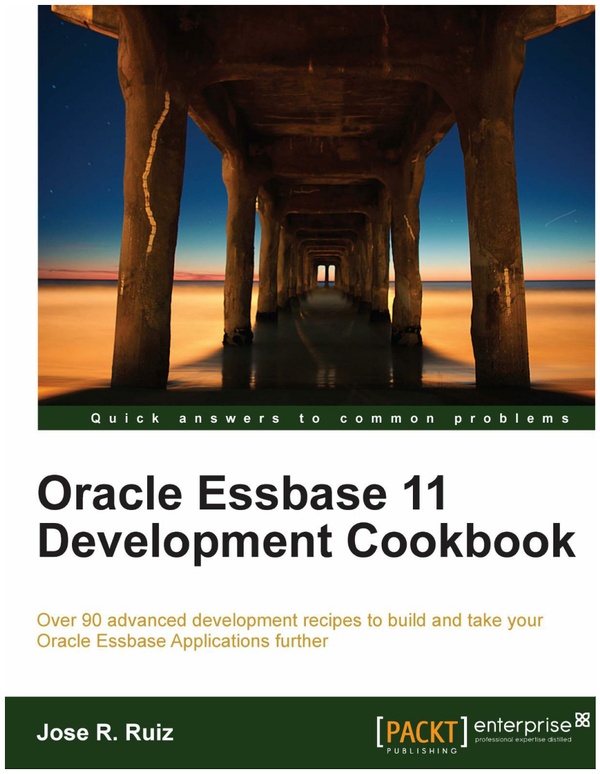Oracle Essbase 11 Development Cookbook
Table of Contents Preface Chapter 1: Understanding and Modifying Data Sources Chapter 2: Using Essbase Studio Chapter 3: Building the BSO Cube Chapter 4: Building the ASO Cube Chapter 5: Using EAS for Development Chapter 6: Creating Calculation Scripts Chapter 7: Using MaxL to Automate Process Chapter 8: Data Integration Chapter 9: Provisioning Security Using MaxL Editor or Shared Services Chapter 10: Developing Dynamic Reports Index Preface Up Chapter 1: Understanding and Modifying Data Sources Introduction Setting up an Accou nt or Measures dimension with a parent-child reference Setting up dimensions with a generation reference Adding columns for outline formulas Adding the solve order column to tables that have ASO formulas Adding and populating the Sort Order Column Adding tables for varying attributes Determining hierarchies in relational tables Using the Essbase Outline Extractor to extract dimensions Using Star Analytics to build your star schema from existing Essbase cubes Up Chapter 2: Using Essbase Studio Introduction Creating TBC sample database and connecting to the data source Adding user-defined tables Building your minischema Setting up joins in a minischema Adding tables to a minischema Using a text file data source Working with Common Platform Language (CPL) Using Sort Order on data elements Up Chapter 3: Building the BSO Cube Introduction Creating hierarchies using a parent-child reference table Creating hierarchies using a generation reference table Adding attribute dimensions to hierarchies Building a Calendar dimension Creating date elements Creating Alias tables Developing cube schema and an Essbase model Setting Essbase properties Deploying a cube Creating an OLAP Model in EIS Creating an OLAP metaoutline in EIS Up Chapter 4: Building the ASO Cube Introduction Using the Connection Wizard to set up an ASO cube Building a Measures dimension from the fact table Creating an ASO Cube Schema and an Essbase Model Understanding Essbase Model properties for the ASO cube Designing a drill-through report Using the View dimension for Dynamic Time Series reporting Up Chapter 5: Using EAS for Development Introduction Adding an application and database on an Essbase Server Using the outline editor to add dimensions Using dimension build rules to add the parent-child dimension Creating dimension build rules to add a base and attribute dimensions Using dimension build rules to add user-defined attributes and associate dimensions Creating load rules for flat file data loads Creating substitution variables Using If/Else logic and substitution variables in outline formulas Using Text measures on a BSO cube Using Date measures on a BSO cube Using different outline formula logic at parent level Creating a load rule for SQL data load using substitution variables Using MDX in aggregate storage applications Up Chapter 6: Creating Calculation Scripts Introduction Using Essbase Set function commands and Calc All to calculate cubes Using control flow commands, conditional, and logical operators Using substitution variables in calculations script Using UDAs and Calc Two Pass in calculation scripts Using Attributes in calculation scripts Clearing data and using the cross- dimensional operators in a calculation script Using allocation functions in calculation scripts Modifying Essbase settings to improve calculation performance Using MDX to calculate Aggregate Storage database Up Chapter 7: Using MaxL to Automate Process Introduction Setting up folder structure and other files needed for MaxL automation Executing dimension build rules using MaxL Executing load rules using MaxL Executing calculations using MaxL Executing partitions using MaxL Executing report scripts using MaxL Adding or changing substitution variables with MaxL Using ASO incremental data loads Using encryption in MaxL scripts Deploy dimension created in Essbase Studio Up Chapter 8: Data Integration Introduction Using report script to extract data to a text file Using the DATAEXPORT function to extract data into a text file Using the DATAEXPORT function to extract data into a relational source Exporting data using column format Using MaxL to extract the outline in XML format Using @XREF functions to move data between BSO cubes Partitioning data from BSO to ASO cubes Using MDX for extracting data using API There's more Up Chapter 9: Provisioning Security Using MaxL Editor or Shared Services Introduction Using MaxL editor to add and externalize a user Using Shared Services to add and provision a user Using MaxL Editor to set up a filter for MetaRead and Write access Using Shared Services to provision filters to a group Using Shared Services to provision calculation scripts to a group Using MaxL to export security file Up Chapter 10: Developing Dynamic Reports Introduction Creating a connection and using substitution variables in financial reports Using the column templates and formatting reports Retrieving data using UDAs and Attributes Retrieving data using children and descendants member set functions Using User Prompts and the POV to select members Using conditional formatting and suppression in financial reports Adding related content to financial reports Creating a web analysis report http://www.packtpub.com/oracle-essbase-11-development-cookbook/book
